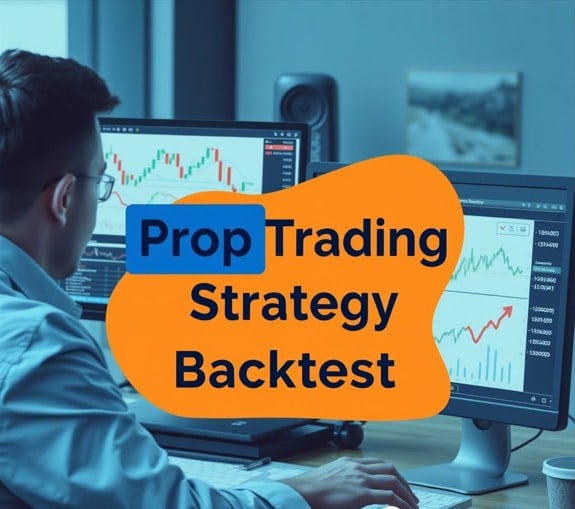Prop Trading Strategy Backtest: How to Backtest Your Strategy for Prop Trading
Executing a reliable prop trading strategy backtest is a critical step for traders aiming to prove profitability before joining a proprietary firm. Without proper backtesting, even the most promising strategies can fail under real-market pressure. This blog will guide you through the entire process of how to backtest efficiently, what tools to use, and how firms like Larsa Capital expect traders to validate their performance.
Why a Prop Trading Strategy Backtest Is Crucial
Before risking real capital or joining a challenge with a prop firm, you need evidence your strategy works. Backtesting provides that proof by simulating trades using historical data to evaluate effectiveness, consistency, and risk exposure.
A proper backtest helps you:
- Identify flaws in your trading setup
- Optimize entry and exit points
- Build confidence through data-driven results
- Align your risk management with prop firm expectations
It’s not about guaranteeing profits, but about understanding your edge and refining your decision-making process.
Core Components of a Strong Backtest
1. Clean Historical Data
The foundation of any accurate backtest is high-quality data. Always choose:
- Accurate OHLC (Open, High, Low, Close) prices
- Data from a reliable provider
- The right time frame for your strategy (1-min, hourly, daily)
Low-quality or incomplete data can invalidate the entire process.
2. Clear Strategy Rules
Before testing, write down exact rules for your:
- Entry and exit criteria
- Stop loss and take profit levels
- Position sizing formula
Avoid making decisions “on the fly.” Consistency is key.
3. Defined Time Period
Backtest over different market conditions—bullish, bearish, and ranging. Ideally, your test should cover multiple years to get a realistic average performance.
4. Proper Risk Management
Include fixed or percentage-based risk per trade. This ensures your results reflect real trading scenarios and potential drawdowns.
Tools to Perform a Prop Trading Strategy Backtest
Manual Backtesting (Spreadsheet-Based)
You can use Excel or Google Sheets to simulate trades manually. Although time-consuming, it teaches discipline and a deeper understanding of your strategy.
Automated Backtesting Tools
- TradingView: Great for visual strategy validation with Pine Script
- MetaTrader 4/5: Supports both automated and manual testing
- Forex Tester: Offers historical simulation and trade journaling
While backtesting manually builds intuition, automated tools save time and reduce human error.
Key Metrics to Analyze After a Backtest
Evaluating performance goes beyond profit. Look at:
- Win rate: Percentage of successful trades
- Profit factor: Ratio of gross profit to gross loss
- Maximum drawdown: Largest peak-to-trough decline
- Expectancy: Average return per trade over time
- Sharpe ratio: Risk-adjusted return
These metrics help you measure strategy quality and prepare for live trading.
Larsa Capital’s Emphasis on Strategy Validation
Larsa Capital encourages traders to present well-structured, backtested strategies when starting a challenge. Their evaluation model values:
- Strategy consistency over short-term performance
- Documented risk management rules
- Realistic expectations and performance benchmarks
They appreciate when traders align backtesting conditions with actual trading rules in the challenge phase.
Prop Trading Strategy Backtest in Realistic Conditions
To make your backtest valid, avoid common mistakes like:
1. Overfitting
Creating a strategy that works perfectly on past data but fails in live markets. Always test on out-of-sample data.
2. Ignoring Slippage and Spreads
Include realistic trading costs in your simulation. Ignoring them will inflate results.
3. Emotional Bias
Backtest objectively. Don’t cherry-pick trades to suit your expectations.
How to Use Backtest Results to Improve Your Strategy
Review Losing Trades
Find patterns in your losing trades. Do they happen in certain market conditions or after news events?
Optimize Parameters
Tweak values like stop-loss distance or entry filters. However, don’t make too many changes based on a small data set.
Compare Multiple Strategies
Backtest several strategies across the same time period. Choose the one with better risk-adjusted returns.
Step-by-Step: Prop Trading Strategy Backtest Blueprint
- Define the strategy rules
- Collect quality historical data
- Choose a suitable platform or spreadsheet
- Simulate each trade consistently
- Record every result and statistic
- Evaluate metrics like drawdown, profit factor, and win rate
- Optimize where needed (without curve fitting)
- Retest with new data for verification
Repeat this cycle until your strategy is both profitable and stable.
Subheading Featuring the Keyphrase: When to Perform a Prop Trading Strategy Backtest
You should backtest your strategy:
- Before joining a prop challenge
- After making changes to an existing system
- When preparing for higher account sizes
- Following periods of losses or underperformance
A routine backtest ensures your strategy remains relevant in evolving market conditions.
Final Thoughts: Make Backtesting a Habit
A strong prop trading strategy backtest is the foundation of any successful trading career. It brings clarity, minimizes guesswork, and helps traders align with firm expectations.
Firms like Larsa Capital value this preparation, and it often sets successful traders apart from the rest.
Investing time in quality backtesting today can save you from costly mistakes tomorrow. Make it a regular part of your strategy development process and you’ll trade with more confidence and consistency.

